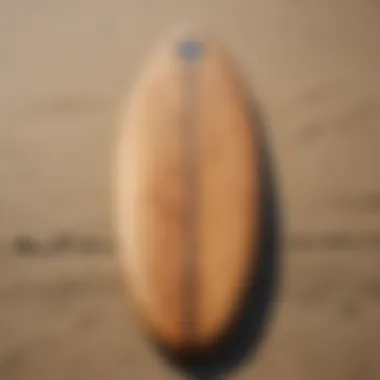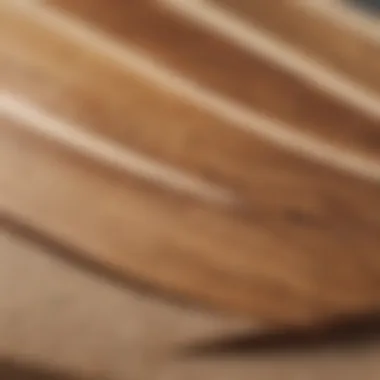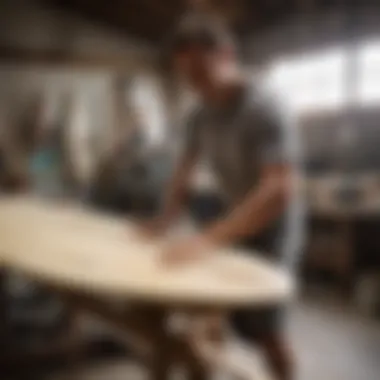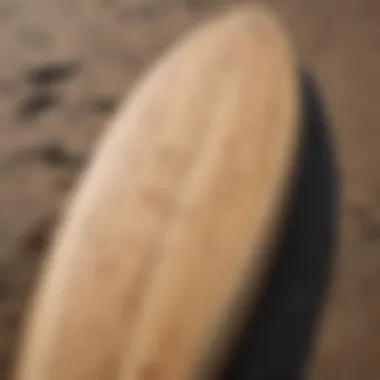Crafting Eco-Friendly Wooden Surfboards: Free Plans


Intro
Crafting a wooden surfboard isn't just an activity; it's a journey into the soulful realm of surfing. The art of building your own board impels a connection with the ocean that's hard to express in mere words. It's about harnessing the beauty of nature while embracing sustainable practices. Free plans available for wooden surfboards allow both newcomers and seasoned surfers to construct boards that not only cater to individual needs but also reflect personal style. This article will explore the nitty-gritty of these plans, discussing everything from materials and techniques to environmental considerations.
Surf Gear and Equipment
When embarking on the adventure of crafting a wooden surfboard, understanding the fundamental gear and equipment is crucial. In this section, we'll delve into what you really need to get started.
Essential Tools for Building
Building your own wooden surfboard requires a specific set of tools to ensure precision and quality. Here are some essentials:
- Saws: A table saw or a band saw will be your best friends for cutting large pieces of wood into the desired shapes.
- Sanders: Getting that smooth finish is important, and a random orbit sander can really help.
- Clamps: These are vital for holding pieces together while the glue sets.
- Measuring Tools: A tape measure and a square are essential for accuracy.
- Resin and Fiberglass: These materials are necessary for waterproofing and reinforcing your board.
Latest Surfboard Technologies
While traditional wooden surfboards hold nostalgic charm, newer technologies have made waves too. Here’s what's trending in the surfboard world:
- Eco-Friendly Resin: Options like bio-resin are gaining traction for their sustainability.
- Lightweight Materials: New composites offer similar performance to wood without the hefty weight.
- Fin Systems: Systems that allow for quick fin replacements can enhance performance and versatility.
Getting acquainted with these innovations can aid in making an informed choice about what to incorporate into your board design.
Essential Accessories for Surfers
Once your board is complete, remember that a few accessories can enhance your surfing experience:
- Leash: This connects you to your board, preventing it from drifting away.
- Wax: A necessary item for grip on the board, ensuring you don't slip.
- Deck Pad: For extra grip and comfort while riding.
Each accessory plays a role in both safety and performance, making them fundamental for any surfer.
Techniques and Skills
As you delve deeper into wooden surfboard crafting, it's essential to build up your skills and techniques not just for crafting, but for enjoying surfing itself.
Safety and Surf Etiquette
Surfing is as much about respect as it is about riding waves. Understanding safety practices and etiquette can not only keep you safe but also ensure an enjoyable experience for everyone in the water:
- Know Your Limits: Don’t push yourself beyond your skill level.
- Respect the Surf Zone: Be aware of who has the right of way on waves.
- Be Conscious of Others: Avoid dropping in on someone else's wave.
"Respect is earned, not given; this applies doubly in the surf."
By adhering to these guidelines, you can enjoy the camaraderie of the surfing community.
Finale
As we surf through these intricate waters of wooden surfboard creation, the knowledge and skills gained enable passionate surfers to harmonize their values with their craft. In the upcoming sections, we will examine specific plans and the materials needed for building your own unique surfboard. The goal remains clear: to empower enthusiasts to shape their surfing journey, one wave at a time.
Prologue to Wooden Surfboards
In the world of surfing, the choice of surfboard isn't just about performance; it often reflects a deep-seated connection between surfers and their craft. Wooden surfboards, in particular, have garnered attention for their unique blend of craftsmanship, sustainability, and rich history. For many, riding waves on a wooden board adds a touch of nostalgia, invoking memories of surfing's origins. Unlike typical foam boards that have come to dominate the market, wooden surfboards showcase individuality—each one tells a story, bearing the marks of its creator.
The importance of understanding wooden surfboards goes beyond mere aesthetics. As we dive into this exploration, we'll touch on elements like the craftsmanship involved, the materials used, and how these boards can contribute to a more eco-friendly lifestyle. Consciously opting for wooden boards is akin to making a statement in favor of sustainable practices. Now, let us trace back the historical roots that give wooden surfboards their charm and significance.
Historical Context
Wooden surfboards are not a modern fad. Their origins stretch back to ancient Polynesia, where the earliest surfers crafted boards from native woods. These early surfboards were not just equipment; they held cultural and spiritual significance. For instance, the Hawaiian ‘alaia and olo boards were shaped by skilled artisans, reflecting the skill passed down through generations. Over time, as surfing evolved, so too did the materials. In the mid-20th century, the advent of fiberglass boards sparked a revolution, eclipsing wooden boards with lightweight options. Yet, in recent years, there’s been a resurgence of interest in traditional materials. The resurgence pays homage to those early artisans, reminding us of the allure and uniqueness of handmade craftsmanship.
Material Characteristics
The choice of materials for wooden surfboards is critical to their performance and sustainability. Generally crafted from softwoods, such as cedar or pine, or hardwoods like mahogany or oak, the type of wood significantly influences weight, flexibility, and the board's overall aesthetic appeal. Softwoods, while lighter, may not offer the same durability as hardwoods, making the right selection essential based on the surfer's style and intended use.
It’s noteworthy that wooden surfboards have an organic feel that foam or epoxy boards lack. When a wooden board glides across water, it often produces a different sensory experience. The sound of wood cutting through the waves feels familiar and inviting, unlike the sometimes harsh sound of synthetic materials. Furthermore, wooden boards can be maintained for years, if not decades, with proper care, making them not just a sustainable choice but also an investment in craftsmanship.
"Crafting a wooden surfboard is akin to creating a piece of art; each stroke, each layer, tells a tale of dedication and passion."
In essence, wooden surfboards represent a profound commitment to both surfing culture and environmental stewardship. Understanding their historical significance and material characteristics enriches the surfer's experience and serves as a reminder of sustainable practices in a world often dominated by fast-paced consumerism.
The Allure of Free Plans
In the realm of wooden surfboards, the concept of free plans holds a treasure trove of benefits that attract both budding enthusiasts and seasoned builders alike. The accessibility of these plans makes it easy for anyone to dive into the art of crafting a wooden board, regardless of their prior knowledge. Also, as the waves roll in and out, so do the economic challenges faced by individuals wanting to pursue their passion. Free plans can serve as a solid foundation, empowering surfers to engage with the craft without breaking the bank.
Accessibility for Beginners
Free plans serve as an inviting gateway for those who might feel hesitant to embark on the journey of building their own surfboard. Whether it’s a lack of experience or resources that holds them back, having access to these blueprints paves a smoother path. But it’s not merely the absence of cost that is appealing; it’s about fostering creativity without the shadow of financial worry.
For beginners, diving into a project can feel like jumping off a tall cliff. However, with detailed instructions and helpful illustrations, these free plans can motivate the timid to give it a shot. Here’s how they do it:
- Clear Instructions: Many of the free plans include step-by-step guides, often accompanied by visuals, which demystify the process of constructing a surfboard.
- Community Support: Online forums on platforms like Reddit can offer assistance and tips as newcomers tackle the nuances of their first build.
- Experimentation: Beginners can afford to make mistakes without the fear of wasting money on expensive materials. It allows them to learn and adapt their techniques without significant financial repercussions.
Cost Benefits
When it comes to the financial aspect, free plans present a downright attractive proposition. Engaging in the surfboard-building endeavor typically involves purchasing materials and tools that can add up quickly. Free plans mitigate some of these costs, providing a more accessible entry point into the sport.


Consider the following:
- Material Savings: Acquiring free plans means that the costs associated with hiring a designer or purchasing plans can be completely avoided. This saving can be redirected toward high-quality wood or additional tools.
- Lower Entry Barriers: New builders can manage a budget that suits their financial situation, opening up avenues for skill development without substantial investment.
- Shared Knowledge: Many avid surfers and builders will share their experiences and techniques, often for free, allowing others to gain valuable insights without the need for costly workshops.
"Crafting your surfboard can transform from a wishful thought into a tangible reality, thanks to the abundance of free plans and resources available today."
Altogether, the allure of free plans lies not just in the monetary aspect but also in the community, creativity, and confidence it builds among aspiring surfboard makers. With these free resources at their fingertips, anyone can take a step towards creating their own unique board, embracing both the craft and the waves.
Types of Wooden Surfboard Designs
When it comes to building your own wooden surfboard, the design you choose can significantly influence both your surfing experience and the overall performance of the board. Understanding the different types of designs available is not only beneficial but essential for ensuring that the board meets your surfing style and the conditions you typically ride in. Each type of surfboard—longboards, shortboards, and hybrid models—has its unique characteristics, advantages, and considerations that cater to varied skill levels and preferences.
Longboards
Longboards are often seen as the classic surfboard, offering a smooth ride and stability that many surfers appreciate. Ranging from about 8 to 12 feet, longboards favor a more relaxed style of surfing. The longer length generally means more surface area, which can help in paddling, making it easier to catch waves early and maintain momentum.
Their design features a rounded nose and a wider body, contributing to stability, especially in small to medium swells.
- Benefits of Longboards:
- Great for beginners due to stability.
- Ideal for nose riding, where surfers can ride up near the front of the board.
- Suited for smaller wave conditions, allowing for enjoyable rides even when the surf isn’t aggressive.
However, it’s important to note that longboards can be cumbersome to maneuver in heavy surf. Their weight might challenge a more advanced surfer looking for sharper turns and quicker transitions. Still, for many, the enchanting glide of a longboard is worth its weight.
Shortboards
Shortboards, typically ranging from 5 to 7 feet, are designed for performance. These boards are characterized by a thinner profile and a narrower tail, making them much more agile and suited for high-speed turns and tricks.
- Key Aspects to Consider:
- Better suited for stronger and more powerful waves.
- Ideal for experienced surfers who can handle the quick response needed for dynamic movements.
- Lightweight and easy to maneuver, allowing for advanced techniques and aerial tricks.
However, shortboards lack the paddling ease that longboards provide. Catching waves can be trickier, especially for beginners. Therefore, choosing a shortboard means committing to a steeper learning curve. But for those who crave excitement and enjoy pushing their limits, the payoff can be tremendous.
Hybrid Models
Hybrid surfboards blend features of both longboards and shortboards, resulting in versatile designs that can cater to various surfing styles and conditions. These boards offer a balanced approach, maintaining the paddling ease of longboards while integrating the maneuverability of shortboards.
- Advantages of Hybrid Models:
- Flexibility to ride different types of waves.
- Comfortable for both beginners looking for stability and intermediate surfers seeking performance.
- Customizable designs for personalized experience.
This adaptability makes hybrids a popular choice among surfers who surf various conditions. However, it’s essential to be careful when choosing the specific shape and dimensions to ensure it meets your intended style.
In summation, diving into the world of wooden surfboard designs greatly influences how you connect with the waves. Understanding longboards, shortboards, and hybrids, their respective traits and advantages, will empower you to make informed decisions as you embark on your surfboard-building journey.
"Every wave you ride can teach you, but the board you choose plays a critical role in that learning."
In the subsequent sections, we'll explore the materials for building these designs, ensuring that every surfer can craft a board that speaks to their individual journey on the water.
Materials for Building Wooden Surfboards
When embarking on the journey of crafting wooden surfboards, the choice of materials is paramount. Each selection can influence the board's performance, durability, and even aesthetic appeal. These factors make understanding materials an essential focus in the realm of surfboard building.
Choosing the Right Wood
Picking the right wood is not just a matter of preference; it is central to the effectiveness of the board in water. Different woods offer various properties such as weight, flexibility, and resistance to the elements. For instance, utilizing a lightweight wood like balsa can lead to a faster and more maneuverable surfboard. On the other hand, hardwoods like mahogany or teak provide enhanced durability but can add extra weight.
Some popular woods to consider include:
- Balsa: Light and buoyant, great for longboards.
- Pine: Readily available and affordable, with moderate flexibility.
- Cedar: Known for its beauty and natural resistance to rot, making it a good choice for all-purpose boards.
Each wood type has its own strengths and weaknesses, and understanding these nuances allows builders to tailor their creations for specific surfing styles and conditions.
Sustainable Sourcing Practices
Sourcing wood sustainably is becoming increasingly essential for builders motivated by ecological considerations. Unsustainable logging practices not only contribute to deforestation but also threaten ecosystems and biodiversity. Thus, choosing materials that are harvested responsibly is critical.
Look for certifications such as
- FSC (Forest Stewardship Council): Ensures that wood products come from responsibly managed forests.
- SFI (Sustainable Forestry Initiative): Focuses on promoting sustainable forestry practices in North America.
One sustainable approach is repurposing reclaimed wood. Surfboards made from reclaimed timber not only offer a unique look but also have a lower environmental impact. This practice breathes new life into materials that would otherwise be considered waste.
"Building with sustainable materials reflects a commitment to preserving our natural environment while enjoying the ocean."
By prioritizing sustainable sourcing, builders contribute to conserving forests and reducing carbon footprints. This thoughtfulness extends beyond the process of construction; it also resonates with the surf community, promoting a shared ethos of environmental responsibility.
In summary, the materials chosen for building wooden surfboards not only dictate the technical qualities of the board but also affect environmental perceptions and practices. Making informed choices about wood types and sourcing can highly influence both the surfing experience and the ecological impact of the sport.
Step-by-Step Process of Building a Wooden Surfboard
Building a wooden surfboard is not just a task; it’s a journey that blends craftsmanship, creativity, and the thrill of the ride. The step-by-step process is crucial as it gives structure to what could otherwise feel like a daunting project. Grasping each step can help both beginners and seasoned builders produce a surfboard that is not only functional but tailored to their personal style. In this article, we’ll explore the process in detail, emphasizing the tools required, the design choices, and the intricate construction techniques involved.
Gathering Tools and Materials


To kick things off, the right tools and materials are the backbone of building a wooden surfboard. It’s like going into battle without your armor – you just can’t do it. You’ll need a good variety of hand tools, power tools, and materials that suit your needs. Here’s a quick rundown:
- Essential Tools:
- Materials Required:
- Circular saw for cutting wood.
- Jigsaw for creating curves.
- Hand planes for finishing edges.
- Sanding tools for smooth finishes.
- Clamps to secure pieces together.
- Quality wood, such as cedar or plywood, for the board.
- Epoxy or polyester resin for sealing and strength.
- Fiberglass cloth for a smoother finish and durability.
Gathering these items may take some time, but it’s well worth the effort. Nothing feels better than working with quality tools and materials, ensuring your creation will endure.
Designing the Shape
Alright, so you've got your tools and wood, but how do you even know what shape to make your board? The design is critical because it influences performance in the water. Consider the style you want to ride and the conditions you usually surf in.
A few key considerations when designing:
- Rider's Skill Level: Beginners might opt for a broader shape, while advanced surfers often choose narrower designs for agility.
- Intended Use: Different shapes are optimal for various surf conditions, whether it's small day waves or monster swells.
- Personal Flair: After all, it’s your board. Be creative and let your personality shine through the shape.
Construction Techniques
The construction of your wooden surfboard can be the difference between a piece of art and a flotation device. Here’s where the magic happens, so pay attention to the details:
Layering
Layering is a technique that enhances the strength and durability of the surfboard. By stacking multiple thin layers of wood, you can create a result that is not only robust but also flexible enough for a better ride. The key characteristic of layering is its ability to distribute stress across the surface of the board, reducing the chances of cracks or breakage.
Advantages:
- Increased strength greatly improves the board's longevity.
- Allows for creative designs with contrasting woods.
However, it can be a bit time-consuming, requiring careful alignment of each layer to maintain consistency.
Shaping
Shaping your board is where aesthetics and functionality merge. This step involves gradually refining the outline and contours until your board resembles the final vision. You’ll need to have a steady hand and a keen eye during this phase. The goal is to ensure that the curves lead to optimal performance in the water.
Benefits:
- Allows surfboards to catch waves more efficiently when finely tuned.
- Offers the opportunity to customize for specific surfing styles.
A novice might struggle with achieving the perfect shape; remember that each mistake can be learned from.
Finishing
The finishing stage wraps everything up, literally. This process involves applying a protective layer, generally of resin, to seal the board, ensuring it withstands the wear and tear of the ocean. A well-finished board will have a sleek look and added durability.
Key Characteristics:
- Provides a water-tight seal, crucial for preventing wood rot.
- Improves overall aesthetics with a polished surface that shines in sunlight.
While finishing can be challenging, particularly with the drying times and the need for even application, it’s what will make all your hard work shine when you finally hit the waves.
Important Note: Remember to be patient and precise with each step. Rushing through can lead to unwanted issues in the water.
Each phase of the process builds upon the last. In turn, every decision in shaping and constructing your surfboard reflects your style and skills. Whether a beginner or a seasoned craftsman, following these steps can lead you to create a board you'll be proud to ride.
Maintenance of Wooden Surfboards
Taking care of wooden surfboards is more than just a chore; it's essential for preserving the beauty and functionality of these handcrafted pieces. A wooden surfboard is an investment, and like any good investment, it needs attention to yield the best returns. Regular upkeep can extend the lifespan of your board, enhance its performance, and maintain its visual appeal. Let's break down what maintenance involves and why it's crucial.
Regular Checks
Routine inspections form the backbone of maintaining a wooden surfboard. You don’t have to turn into a marine biologist, but keeping an eye on a few key areas can save you from bigger headaches down the track. Here's what to do:
- Inspect for Cracks and Dings: Wood is a natural material and can be susceptible to damage. Look closely for any signs of cracks or dings on the surface. These can allow water to seep in, which isn’t good for your board.
- Check for Moisture: Wooden boards are prone to absorbing moisture. Use a moisture meter if you have one, to check that the wood’s internal moisture levels are appropriate. High moisture can lead to rot.
- Examine the Fin Setup: Ensure that your fins are secure and free from damage. A loose fin can lead to instability while riding, not to mention potential further damage to your board.
- Look at the Coating: Clear varnish or resin coatings can wear off over time. Spot areas that may need re-coating to keep moisture and UV rays at bay.
By conducting these checks every few sessions or at least once a month, you catch problems while they're small – before they have a chance to grow into more significant issues. Carrying out regular maintenance might feel labor-intensive, but it's a small price to pay for longevity.
Repair Techniques
In the unfortunate event that your wooden surfboard does sustain some damage, having knowledge of effective repair techniques can keep it riding on the waves longer. Here are some straightforward repair methods:
- Filling Dings: If you find small dings, fill them with an epoxy repair kit. It’s important to clean out any debris first. After applying the epoxy, allow it to cure as per the manufacturer’s instructions.
- Fixing Cracks: For longer cracks, ensure you sand the area around the crack smoothly, apply a wood filler, and then sand again once it’s dried. You may also want to apply a fresh coat of varnish to blend it into the existing finish.
- Moisture Damage: If your board has absorbed water, it may start to swell or lose its shape. If this happens, drying it out slowly in a warm area can help. If rot sets in, you may need to carve out the damaged area and patch it up with fresh wood.
- Refinishing: Periodically, your board will benefit from a full refinish. Sand off the old finish and apply a new coat of varnish. This act not only improves aesthetics but also provides new protection against environmental elements.
Repairing your surfboard can feel daunting, yet it’s often quite manageable if you approach it step by step. Keeping your board in good working condition means you can focus more on the waves and less on worries.
"A well-maintained surfboard is like a trusted friend, always there to take you on exciting adventures."
By embracing these principles of maintenance and repair, you ensure that your wooden surfboard remains a cherished companion in your surfing journey.
Environmental Considerations
Understanding the environmental considerations when crafting wooden surfboards offers a dual advantage: it enhances the quality of the surfboards themselves and safeguards natural resources. Considering the ecological implications related to surfing gear is becoming increasingly important. Surfers are generally eco-conscious, seeking ways to enjoy their passion while minimizing their carbon footprint. Here, we explore critical aspects that highlight why these considerations matter.
Impact of Traditional Materials


Traditional surfboard materials often include polyurethane foam and fiberglass, which come with a hefty ecological price. These materials may offer surfboards durability but at the expense of our environment, generating waste that can take decades to decompose. It's a considerable issue, particularly for proud surfers who aim to create a sustainable practice.
Using wood instead of synthetic materials shifts the dynamics significantly. Timber can be sourced from sustainable forests, ensuring management practices that allow for regrowth. When a tree is chopped down responsibly, it can lead to new seedlings sprouting. Properly managed, this cycle encourages a balanced ecosystem.
Moreover, wooden boards are often treated with natural oils and sealants, further reducing their environmental impact. Take, for instance, the use of bamboo, which grows rapidly and has a minimal ecological footprint. It absorbs large amounts of carbon dioxide while producing a sizeable oxygen output. Therefore, wooden surfboards provide a lower impact alternative without sacrificing performance.
Ecological Benefits of Wood
When we embrace wooden surfboards, we’re not just choosing an aesthetically pleasing craft; we’re backing an eco-friendly option. The advantages of opting for wood are numerous.
- Biodegradability: Unlike many synthetic surfboards, wooden surfboards do not linger in landfills for eternity. When their surf days are over, they can decompose naturally without releasing harmful toxins back into the soil.
- Energy Efficiency: The process of producing wooden surfboards typically consumes less energy compared to the production of traditional boards. Less energy use equates to fewer fossil fuels burned, contributing lightly to the overall carbon footprint of surfing activities.
- Sustainability: Many woods used in surfboard construction are harvested from renewable resources. This means that as long as surfing communities support sustainable forest practices, they can maintain a continual supply of materials without harming the environment.
In a world where climate change is a pressing concern, emphasizing ecological benefits through materials like wood becomes essential. Surfers can feel good about their choice, knowing they are making decisions that positively impact the environment.
"Crafting surfboards with consideration for the environment transforms a passion into a purpose, merging enjoyment with responsibility."
By embracing the craft of building wooden surfboards with a focus on sustainability, surfers not only enhance their experience in the water but also contribute to a more eco-conscious world. It’s a harmony between sport and stewardship, reflecting the surf culture’s evolving landscape.
Embracing the Craft
The journey of crafting your own wooden surfboard is not just about the end product; it's deeply rooted in the experience and the process itself. Embracing the craft means diving into the world of woodworking and surfboard design, allowing enthusiasts to connect with their passion for surfing on a personal level. This section illuminates why developing this craft can be a transformative experience for many, touching on communal aspects, skill-building, and emotional fulfillment.
Joining Community Workshops
Community workshops are fantastic avenues for budding builders. These gatherings often welcome individuals regardless of their skill level, creating a warm and inviting atmosphere. Participants can learn various techniques that are often passed down from experienced hands to eager learners.
People often share tools and resources, which can ease the financial burden on beginners. Picture a space buzzing with creativity where everyone gets their hands dirty, laughing at the unexpected challenges while also celebrating small victories.
Engaging in these workshops fosters camaraderie among participants who are all pursuing the same dream: creating a surfboard that reflects their style and spirit. Not only does it enhance skills, but it also builds a support network that can last well beyond the workshop.
Engaging with Experienced Builders
There’s a wealth of knowledge among seasoned builders that cannot be acquired from books or online forums. Finding a mentor or simply engaging in conversations with experienced surfboard builders can provide insights that help rise above basic craftsmanship.
Many experienced builders have gone through the trials and tribulations of surfboard construction. They can offer advice on materials, techniques, and design choices that fresh builders might not consider. Think of discussions revolving around subtle changes in sandpaper grit or the right type of finish for different wood varieties. These details make a significant difference in the final product.
Engagement can happen in various formats: one-on-one sessions, group meetups, or even attending demonstrations at local events. These interactions enrich the learning experience, allowing new builders to shortcut potential mistakes.
"A good teacher explains. A great teacher inspires."
By developing a relationship with experienced builders, newcomers can not only learn about the craft but also immerse themselves in the culture surrounding surfboarding, which often reflects a deep-rooted love for ocean and nature.
In summary, embracing the craft of wooden surfboard building opens up a realm of opportunities for learning, connection, and personal growth. Whether through community workshops or guidance from seasoned builders, each step along this path takes a surfer closer to their ideal board, ultimately enhancing their experience on the water.
Frequently Asked Questions
In any endeavor, questions inevitably arise. When it comes to building wooden surfboards, especially while looking at free plans, it can feel a bit overwhelming. This section aims to demystify some common uncertainties, offering clarity to both novice builders and seasoned surfers.
Understanding the cost implications and the complexity of the construction process hold significant weight in this craft. Knowing what to expect can make all the difference between diving in headfirst or lingering in the shallows. Readers should expect a comprehensive exploration of practical insights that answer pressing concerns.
What are the cost implications?
Building a wooden surfboard can run the gamut, financially speaking. On one hand, the allure of free plans is undeniable, but one must not forget to consider the hidden costs that might crop up along the way.
- Material Costs: While the plans may not cost a dime, sourcing quality wood is essential. Depending on where you're located, prices can vary considerably. For instance, high-quality cedar or mahogany might set someone back to a couple hundred dollars, while more common types like pine can be more budget-friendly, often available at local lumber yards.
- Tools and Equipment: Even if you are getting a free plan, you'll still need tools – and not just your granddaddy's saw. If you're starting from scratch, expect to invest in tools like a jigsaw, clamps, sanders, and finishing equipment. This can add another few hundred dollars to the tab. However, many builders find joy in acquiring these items as they see them as investments in their craft.
- Workshops and Classes: If you prefer hands-on learning, workshops can be a fantastic investment, albeit one that may stretch your wallet further. Local community centers or surf shops might offer classes, and prices can range widely depending on the facilitator.
In sum, while the free plans themselves save you a dime, the entire fabric of building a wooden surfboard requires a more comprehensive look at costs. That’s the reality check - hidden costs can pile up subtly but surely.
Is it difficult to build one?
The labor involved in crafting a wooden surfboard shouldn't be underestimated. But, saying it's "difficult" is a subjective matter. It can indeed be complex, but it’s also part of the charm and challenge.
- Skill Level: If you’re coming in without any experience, it's natural to feel a little daunted. However, wooden surfboards have a forgiving nature; the materials often allow for adjustments during the process. Many builders find the learning curve invigorating rather than discouraging.
- Following Plans: Utilizing well-detailed free plans makes a huge difference. You can follow step-by-step instructions, lessening the likelihood of missteps. Each completed step builds confidence, transforming daunting intricacies into manageable tasks.
- Time Commitment: Allowing enough time is crucial. Rushing through can lead to mistakes, so patience is not just a virtue; it's essential. Crafting your own surfboard might take days or even weeks, but that's where the satisfaction lies – in the artisanal dedication.
"Wooden surfboard building isn't just about the end product; it's about enjoying the journey and craftsman's pride."
As you hover over plans and tools, remember to weigh the emotional and financial investments. With the right approach, this endeavor can be a deeply satisfying experience, helping you slip seamlessly into the surf with a board that bears your personal touch.
End
Crafting wooden surfboards through accessible, free plans opens up a world that’s not just about riding waves, but about embracing a rich, hands-on tradition. The journey from selecting the right materials to shaping your very own board is both a personal and creative process.
Reflections on Craftsmanship
When it comes to craftsmanship, there’s more than just the physical act of building a board at play. It is essential to recognize the value of pursuing an art form that demands patience and precision. The satisfaction that stems from meticulously crafting a surfboard from scratch cannot be understated.
- Each crack, each curve, tells a story, one that is uniquely yours.
- Older surf builders often reflect on the years spent learning, understanding that mistakes are as valuable as successes.
- There’s an intrinsic connection to the materials involved; wood possesses a character that synthetic materials can’t replicate.
Additionally, recent waves of interest in sustainable practices add a deeper layer to this craft. As builders, the responsibility lies not solely in creating a board that can cut through the surf but also in ensuring that the methods employed preserve the very environment we cherish. This thought transforms each wooden surfboard into not just a piece of equipment, but a personal commitment to eco-consciousness.
"In the act of creation, there is a reflection of the creator."
Encouragement to Explore
As we wrap up this discussion, I urge you to dive headfirst into the world of wooden surfboards. Whether you are a seasoned surfer or a newcomer to the ocean, the benefits of embarking on such a project are manifold. By giving it a shot, you are not just crafting a surfboard; you are nurturing curiosity and creativity.
- Explore the diversity of free plans available that suit your skill level.
- Engage with communities that cherish this craft - there’s plenty of shared wisdom in forums and workshops.
- Take advantage of sustainable materials because it’s not just a trend; it's the right choice.
Ultimately, crafting your board will incite a deeper connection to the craft and the sea. Your hands will guide your effort, and in return, the waves will greet your labor of love. Step back from the ordinary, put together your desired wood types, and let your creativity flow. Embrace the process; the ocean beckons!
By concluding this exploration, the message remains clear: this isn’t just about building boards. It’s about community, sustainability, and an unmatched bond with the sport. Dive in, take that leap and consider every board you shape a unique testament to your craftsmanship.















